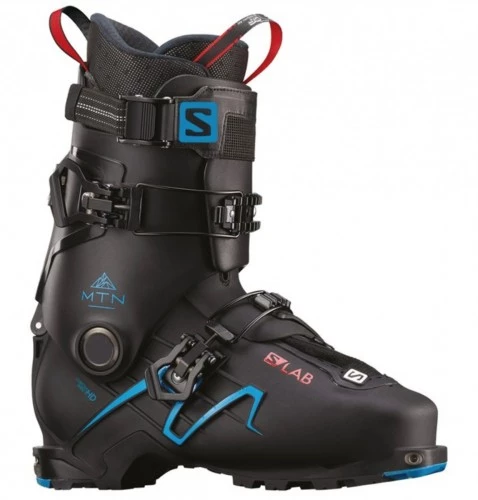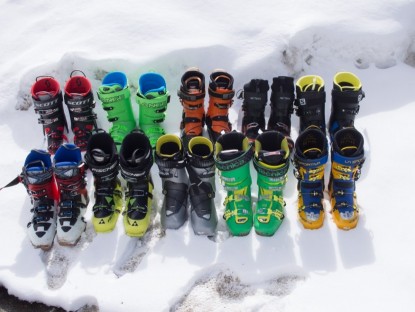Salomon confirm they changed the name of this product from Mtn Lab to S/Lab MTN and updated its colorways. This year's boot also features custom heat moldable liners. See the new version pictured in the photo above.
February 2019Salomon S/Lab MTN Review
Our Verdict
Our Analysis and Test Results
With the now well-established Mtn Lab, Salomon created a modern classic that hits a sweet spot for a large portion of the AT ski boot buying market. If you are an all-around backcountry skier with downhill leanings and low volume feet, give careful consideration to the MTN Lab. The Mtn Lab is an excellent all-around AT ski boot for a downhill ski technician willing to lug a few extra ounces and willing to do some fitting work.
Uphill Performance
Looking at just uphill performance, the Mtn Lab is nothing special. This says more about the state of modern AT ski boots than it does the Mtn Lab. As compared to the broad range of products we tested, the Mtn Lab sits just below the middle, in terms of uphill performance. The cuff range of motion, measured in our repeatable, standardized fashion, sits almost exactly in the middle. The friction and resistance within that range are fairly average also. It doesn't tour as freely as some, but it is way better on the uphill than the Top Pick optimized for downhill performance. Just five years ago, this sort of cuff range and uphill performance would have led the field. Now we expect this sort of touring compromise only from the best downhill performing boots.
Weight
Like with uphill performance, the weight of the Mtn Lab is nothing special. Again, five years ago, seven pounds (which is what the Salomon weighs, roughly) was the benchmark for all-around AT ski boots. And those boots five years ago didn't tour or ski as well as the Salomon. We have boots in our test that are heavier, and they generally ski better.
Some are heavier, but most AT boots now are lighter than seven pounds. In fact, we consider six pounds, or just a little bit less, to be the typical weight for an “all-around” human-powered AT ski boot.
Downhill Performance
Assessing downhill performance of AT ski boots is easy; describing that downhill performance is more difficult. The easy part is the skiing. Within a few turns, our competent test team has adjusted to the new equipment and is “sizing them up”. We try and summarize the attributes in terms of responsiveness and stiffness. Stiffness is a function of materials and construction, while responsiveness is a function of stiffness and fit. We want boots that, when locked into downhill mode, are stiff -almost rigid- to the sides and back. We want the forward flex to be immediate, even, and graduated. That forward flex is the tough thing to tune.
Lightweight boots can use materials and construction that make them stiff all around, but getting a “progressive” forward flex is trickier. Traditionally, two-piece, overlap constructed boots offer the smoothest progressive forward flex. The issue is that overlap boots are heavier and tougher to tour in, all else equal, than tongue boots. The Mtn Lab is a tongue boot for touring comfort and light weight. It is also among the best flexing tongue boots we've ever used. If one were to put it on “blind”, that user might have a difficult time telling it wasn't an overlap boot. The aft and rearward flex are supportive, and the close fit makes the whole Mtn Lab boot super responsive. In this weight class, only the overlap constructed products exceed the Mtn Lab in downhill performance.
Comfort and Fit
The Mtn Lab is the narrowest boot in our test. Straight out of the box, it is unlikely to fit a large percentage of the population. The last is narrow side to side and has an overall volume that is pretty small too. This boot will appeal to the downhill skiing technician with narrow feet.
That technically inclined consumer should have no problem employing the services of an excellent boot fitter to get the Mtn Lab to fit just right. The performance attributes are worth it, and as that expert boot fitter will tell you, it is easier to make a boot bigger than it is to make it smaller. Choose the Mtn Lab for its performance attributes, and put in the work to make it comfortable and fit well.
Warmth
It's like a broken record, but this pair comes out right in the middle, warmth wise. It seems that in almost every category, it comes out around average. That is good when many of the scoring metrics are opposed to another. What makes a boot go uphill well can make it go downhill poorly. What makes a boot warm (thick materials in liner and shell, essentially. Aside from fit, of course) can make it heavy. For the weight, the Salomon is plenty warm. Of the boots that ski well, the Salomon is a little colder. Of the boots that tour really well, the Salomon is much warmer.
Ease of Use
In a matrix that compares ease of use to downhill ski performance, the Mtn Lab would come out on top. The only boots that ski better have twice as many buckles and are far harder to get in and out of. Overlap boots are notoriously hard to get on and off. The Mtn Lab, with its tongue design, doesn't suffer this same fate. Salomon also carefully eliminates buckles to save both weight and transition time when switching between uphill and down. When one considers downhill ski performance, the Mtn Lab is very easy to use.
Value
For the performance, it almost doesn't matter the price. When we eliminate the outlier ski boots, there is very little spread in the price of AT ski boots. At this retail price, and often on sale and widely available, the Mtn Lab is not exorbitantly priced. The materials are sturdy and the performance is high, so we can recommend it for the price.
Conclusion
Salomon has a winner. The Mtn Lab boot melds uphill and downhill performance to hit a sweet spot with wide appeal. Many many skiers will do well with this product. If it seems too heavy or too constrictive on the way up, check out the lighter and more flexible options we've assessed.








